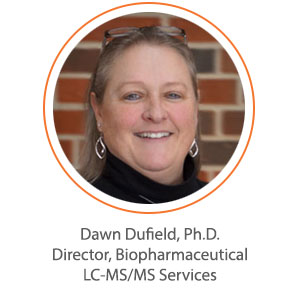There has been an increasing focus on large molecule therapeutics and pharmaceutical companies have increasingly aligned their development pipelines in that direction. This has resulted in more biological therapeutics coming to market. Last year, in 2020, 15 of the 53 new approved drugs were large molecules.
Historically, bioanalytical support for large molecule development has utilized ligand binding technologies. LBA has been the platform of choice for pharmacokinetic, pharmacodynamic and anti-drug antibody analyses relying on the quality of reagents to help provide sensitive and selective assays.
However, focusing only on one technology can significantly hinder the bioanalytical strategy needed for today’s biologics. The improvement in mass spectrometric technology coupled with specific sample prep approaches has resulted in a growing focus on quantitation of large molecules using LC-MS/MS. Hybrid or traditional LC-MS/MS provides an ideal complement to the more established ligand-binding approaches.
We have long exploited the ability to deliver sensitive & specific assays for small molecules by taking advantage of an analyte’s chemical properties. Optimization of extraction, chromatography and mass spectrometric parameters make it possible to determine low concentrations of analytes in the presence of other matrix components. Combining the principles of ligand binding for target analyte enrichment with LC-MS/MS provides an alternative platform for quantitation of large molecules. The addition of an enzymatic digestion to produce a range of characteristic peptides provides surrogates that are more compatible with the mass range of many quantitative MS instruments.
LC-MS/MS can provide significant advantages to quantitate large molecules and we have seen a number of examples where LC-MS/MS provided a clear path forward when an LBA approach met significant hurdles.
Where a sandwich LBA assay needs two reagents for success, hybrid LC-MS/MS can be successful depending on whether one or no reagents are available for enrichment. Furthermore, the available reagent does NOT need to be extremely selective. All we need to achieve is the enrichment of the target analyte because the actual selectivity of the assay comes from multi-step approach of extraction followed by chromatographic separation and availability of unique MS/MS transitions. Hybrid LC-MS/MS also lends itself to ready translation between species where sequence changes are observed. The selectivity can be chosen or “dialed-in” by quantifying specific peptides that are not involved in the antibody binding enrichment step.
A key gain using LC-MS/MS for bioanalysis of large molecules is the flexibility that is gained from choice of surrogate peptide. Screening multiple peptides allows us to assess sensitivity and selectivity to define the path forward. In addition, we can look at different regions of the large molecule to refine the analysis to answer particular questions about a biomolecule. In a recent example, our ligand binding assay demonstrated that there was a stability issue for a target analyte. Transitioning the assay to LC-MS/MS allowed us to choose surrogate peptides from the N-terminus, C-terminus and the central regions of the analyte. We observed that the N-terminus peptide declined with time while the other peptides were sustained. Additionally, the activity of the therapeutic was maintained indicating that the N-terminus was not required for activity. In this example, the hybrid LC-MS/MS was not only the only method that could accurately quantify the protein, it was also able to provide a wealth of additional information about the stability of the molecule.
Hybrid LC-MS/MS provides the ability to measure multiple analytes with slight differences such as a minor sequence change or chemical modification at a single amino acid within the sequence. Again, the ability to select multiple surrogate peptides can help provide multiple answers about a sample. Selection of a surrogate peptide that includes the site of modification allows us to measure both the altered and unaltered biologic. Selection of a common peptide means we can derive a “total” concentration based on multiple analytes.
Another factor that can make hybrid LC-MS/MS attractive is time. Generation of high-quality reagents is not essential meaning that method development and subsequent activities can move forward quickly. This has the added benefit that we can initiate Hybrid LC-MS/MS assays at short notice if a ligand binding method encounters analytical issues. LBA typically requires two antibodies, one for capture and one for detection. The hybrid LC-MS/MS uses one antibody for capture and then the MS to detect the surrogate peptide. The LC-MS/MS approach can easily change the detector peptide and/or detect multiple peptides. If you needed to do this in the LBA assay you would need to generate a new antibody each time the “detector” was changed. This gives the LC-MS/MS approach a huge advantage in speed and flexibility for assay development.
KCAS is a strong advocate of assessing the relative merits of available technologies to answer a project’s needs and using that decision to drive project support. In the past, our ligand binding team provided the majority of our large molecule bioanalysis support. However, more recently, the power and selectivity of LC-MS/MS in large molecule bioanalysis is moving this technology into the mainstream for many PK and biomarker needs and we see hybrid LC-MS emerging as an increasingly valuable tool for the bioanalysis of large molecules.

